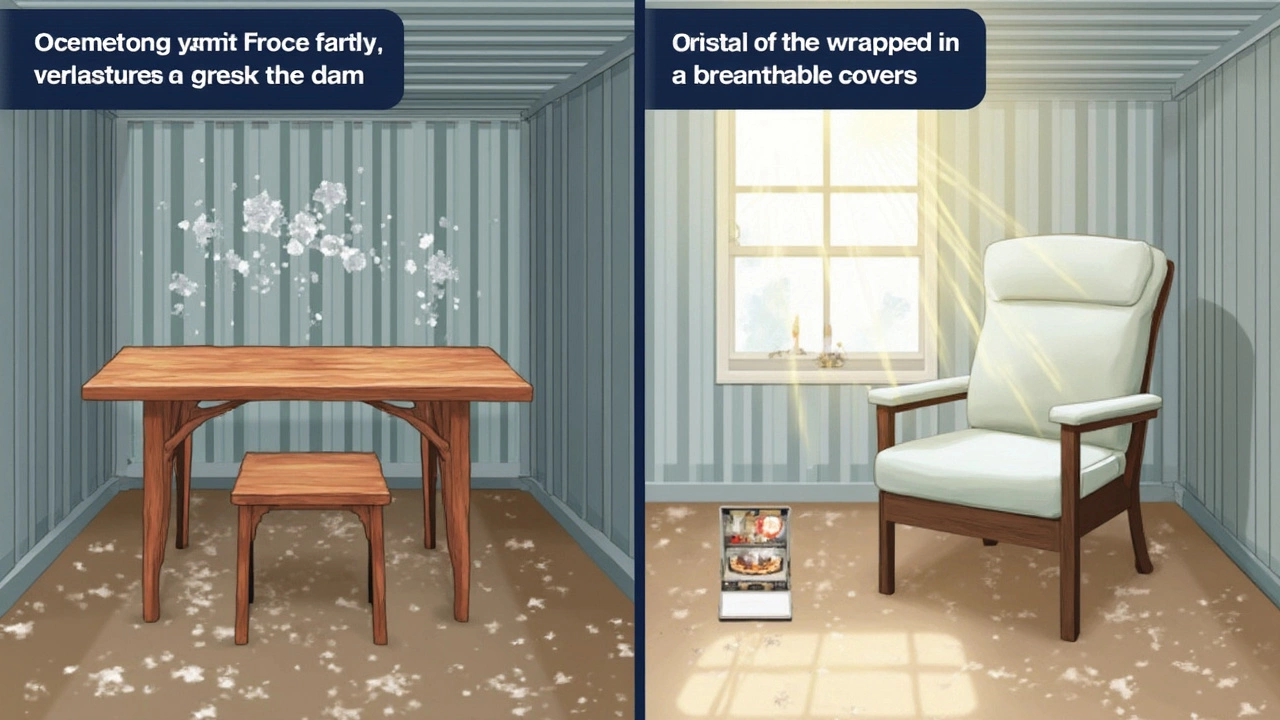 24
May,2025
24
May,2025
Ever peeked inside a storage container only to worry your stuff might come out smelling like a musty old basement? Mould is sneaky, and it loves dark, damp spots—just like those inside containers. The big question is: will your furniture actually turn into a science experiment with green and white patches?
Humidity is the main villain here. When you shut furniture away, especially in places with bad airflow or climate swings, trapped moisture makes mould call your container home. If you live somewhere humid, the risk gets bigger fast. Even a slightly damp couch or mattress can kick off a mould party before you know it.
The good news is you don't have to leave it up to luck. Knowing what causes mould and how it latches onto furniture helps you make smarter choices and save yourself expensive cleanups later. Stick around for real advice that actually works.
- Why Does Mould Grow on Stored Furniture?
- What Makes Containers Risky?
- How Can You Prevent Mould?
- Signs of Trouble and What to Do
Why Does Mould Grow on Stored Furniture?
Mould doesn’t just pop up out of nowhere—it needs a few key things. The top culprit is moisture. Throw in warm temperatures, lack of airflow, and organic materials like wood, fabric, or even the padding in your couch, and it’s party time for mould spores. Basically, your locked-up storage container can become a perfect playground if conditions are right. That’s why you’ll often notice this problem more when seasons change or after rainstorms.
Most people don’t realize that furniture actually soaks up moisture from the air, especially materials like untreated wood and fabric. Once damp, these materials make perfect food for mould. That’s why even furniture that looked dry when you stored it can get mouldy if the air inside your container’s humid.
Mould growth also loves darkness. Containers block sunlight, which normally helps dry out surfaces and kill mould spores. No light means spores can spread across your armchair cushions or under a wooden table without you seeing it coming.
Take a look at how the main factors stack up for mould growth:
| Factor | Ideal Range for Mould | What It Means for Stored Furniture |
|---|---|---|
| Relative Humidity | 60% or higher | Furniture in humid containers is very likely to go mouldy. |
| Temperature | 15-30°C (59-86°F) | Most storage containers hit this, especially outdoors. |
| Material Type | Organic (wood, fabrics, leather) | These materials are mould magnets. |
| Airflow | Little to none | Sealed containers have poor air movement, so moisture gets stuck. |
If you’re curious, fabrics can start showing mould in just a couple of days if the humidity’s up. Wood takes a bit longer, but it’s not immune.
Bottom line—if any damp stuff goes into storage, or the container isn’t sealed tight against outside weather, mould’s going to show up eventually. Once it starts, it can be tough to get rid of. That’s why the rest of this article really drills into prevention tactics.
What Makes Containers Risky?
It’s easy to think of a storage container as a giant toolbox—shut the door and you’re done. But these boxes come with their own set of problems when it comes to keeping furniture safe. The main culprit is moisture. Containers trap humidity like a sauna, especially if they're left outside or opened up on a rainy day. Once that moisture sneaks in, your stuff is on the clock for mould growth.
Most containers are made from metal, which means they heat up under the sun and cool down at night. This temperature rollercoaster creates condensation inside—a real issue if you stack up wooden dressers or fabric couches. One study found that humidity inside a typical metal shipping container can swing from 35% on a cool day to over 90% during a hot afternoon, especially if the container is sealed tight.
Another risk factor: lack of airflow. Fresh air helps keep surfaces dry, but a storage container’s tight seal keeps air from moving. That stale air just lets moisture sit and do its thing. It doesn’t help that people often cram containers full, leaving no breathing room between items.
Here’s a look at how common issues stack up inside containers:
| Risk Factor | How It Adds to Mould Growth |
|---|---|
| Poor Ventilation | Traps humid air, speeds up mould |
| Temperature Fluctuation | Causes condensation on surfaces |
| Damp Items Packed | Direct source of moisture for mould |
| No Moisture Barriers | Lets water seep into furniture |
| Outdoor Placement | Extra exposure to changing weather and leaks |
What really catches people off guard is that just putting things in a container isn’t enough—you have to think about the environment inside. If your main goal is to avoid mould on stored furniture, don’t ignore these hidden dangers. The smartest approach? Know the weak spots, and deal with them before they mess with your stuff.

How Can You Prevent Mould?
Mould only shows up when it’s got the right mix of moisture and warmth, so cutting off its supply is the smart move. First thing’s first: only put dry furniture into storage. Even a sofa that feels just a bit damp can end up being a breeding ground for mould.
Your next line of defense is controlling humidity inside the container. If you’re in a humid area or it’s summertime, moisture sneaks in fast. Pack a few moisture absorbers or desiccant packs with your stuff—they’re cheap and pretty effective at sucking up extra water from the air. If you’re storing things long-term, swap them out every couple of months to keep them working.
Airflow matters, too. Instead of shoving your furniture against the walls, give it a little space. Even a couple of inches between items lets air move and stops condensation from turning into mould. If you’re feeling extra careful, think about adding a small battery-powered fan to the mix, especially for super-heavy or plush pieces.
Furniture covers can also help, but avoid plastic wrap—it traps moisture and makes things worse. Use old sheets or special breathable covers designed for storage, so air gets in but dust and dirt stay out.
- Wipe everything down with a mild cleaner or a mix of water and vinegar before it goes in.
- Don’t store anything that smells musty already. One bad chair can spoil the lot.
- If your container has vents, keep them open as much as possible.
- Check on your stuff every few weeks if you can, especially after heavy rain or big temperature swings.
No method is perfect, but with these steps, you dodge the most common mistakes people make when storing furniture in containers. It’s less hassle now than dealing with a surprise science project later.
Signs of Trouble and What to Do
First warning sign: that weird, musty smell. If your nose wrinkles up the second you crack open your storage container, it’s a red flag for mould brewing inside. Sometimes, you might even spot fuzzy patches—green, white, or black—on fabric, wood, or paper parts of your furniture. Even a chalky residue can mean humidity has already started its dirty work.
Don’t ignore water droplets or moisture collecting on the inside of the container, especially on its ceiling or walls. Foggy windows or condensation are classic indicators the environment is damp enough for mould to thrive. According to the Environmental Protection Agency,
"If you see visible mould, it’s not necessary to test for it. Mould needs to be removed, not just identified."
If you’re worried your items are at risk, here’s a quick checklist of what to do:
- Take everything out and inspect it for mould spots. Pay close attention to the backs and undersides of cushions or wooden pieces.
- Set up a fan or dehumidifier inside the container for a few hours. Dry air slows down mould growth fast.
- Wipe down all surfaces with a solution of vinegar and water (one part vinegar to two parts water works well). It’s cheap and safer around most furniture than bleach.
- If you see heavy mould, especially on wooden parts, let the furniture dry out in the sun. UV rays can kill mould on the surface.
- Replace or add moisture absorbers (like silica gel packs or calcium chloride tubs) in the container to help control humidity going forward.
Be on the lookout for these common trouble-makers—it pays off in the long run. Want to know how risky your storage situation really is? Check out the average humidity levels by region in this table:
| Region | Avg Humidity (%) | Recommended Storage Type |
|---|---|---|
| Coastal Areas | 75–85 | Climate-controlled |
| Midwest | 60–70 | Well-ventilated, with desiccants |
| Desert Southwest | 30–40 | Standard, moisture monitoring |
| Southeast | 80–90 | Strict humidity control |
Bottom line: if you catch problems early and act fast, you can save your furniture from permanent damage. A little attention now means way less stress later on.




